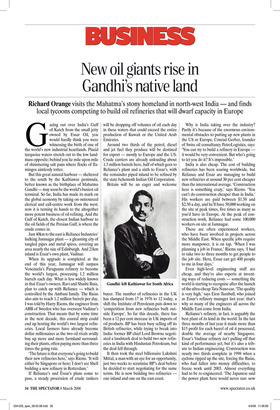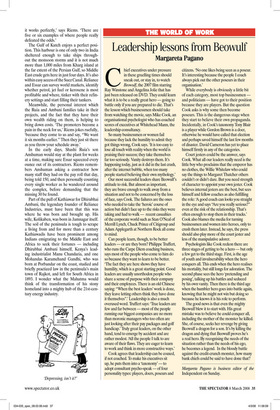New oil giants rise in Gandhi’s native land
Richard Orange visits the Mahatma’s stony homeland in north-west India — and finds local tycoons competing to build oil refineries that will dwarf capacity in Europe Gazing out over India’s Gulf of Kutch from the small jetty owned by Essar Oil, you would hardly think you were witnessing the birth of one of the world’s new industrial heartlands. Placid turquoise waters stretch out to the low landmass opposite; behind you lie mile upon mile of shimmering salt pans where flocks of flamingos aimlessly totter.
But this great natural harbour — sheltered to the south by the Kathiawar peninsula, better known as the birthplace of Mahatma Gandhi — may soon be the world’s busiest oil terminal. So far, India has made its mark on the global economy by taking on outsourced clerical and call-centre work from the west; now it is turning its hands to the altogether more potent business of oil refining. And the Gulf of Kutch, the closest Indian harbour to the oil fields of the Persian Gulf, is where the crude comes in.
Just 40km to the east is Reliance Industries’ hulking Jamnagar plant — a gleaming city of tangled pipes and metal spires, covering an area nearly the size of Edinburgh. And 21km inland is Essar’s own plant, Vadinar.
When its upgrade is completed at the end of this year, Jamnagar will surpass Venezuela’s Paraguana refinery to become the world’s largest, processing 1.2 million barrels each day. What is less widely known in that Essar’s owners, Ravi and Shashi Ruia, plan to catch up with Reliance — which is controlled by the Ambani family. The Ruias also aim to reach 1.2 million barrels per day, I was told by Harry Riems, the engineer from ABB of Sweden who has overseen Vadinar’s construction. That means that by some time in the next decade, this coastal strip could end up hosting the world’s two largest refineries. Local farmers have already become dollar millionaires as the two oil rivals avidly buy up more and more farmland surrounding their plants, often paying more than three times the going rate.
‘The future is that everyone’s going to build their new refineries here,’ says Riems. ‘It will either be Singapore or here: I don’t see Shell building a new refinery in Rotterdam.’ If Reliance’s and Essar’s plans come to pass, a steady procession of crude tankers will be dropping off volumes of oil each day in these waters that could exceed the entire production of Kuwait or the United Arab Emirates.
Around two thirds of the petrol, diesel and jet fuel they produce will be destined for export — mostly to Europe and the US. Crude carriers are already unloading about 1.3 million barrels here, half of which goes to Reliance’s plant and a sixth to Essar’s, with the remainder piped inland to be refined by the state behemoth Indian Oil Corporation.
Britain will be an eager and welcome buyer. The number of refineries in the UK has slumped from 17 in 1976 to 12 today, a shift the Institute of Petroleum puts down to ‘competition from new refineries built outside Europe’. So far this decade, there has been a 12 per cent increase in UK imports of oil products. BP has been busy selling off its British refineries, while trying to break into India: former BP chief Lord Browne negotiated a landmark deal to build two new refineries in India with Hindustan Petroleum, but the deal fell through.
It then took the steel billionaire Lakshmi Mittal, a man with an eye for an opportunity, just two weeks to scrutinise BP’s deal before he decided to start negotiating for the same terms. He is now building two refineries — one inland and one on the east coast. Why is India taking over the industry? Partly it’s because of the enormous environmental obstacles to putting up new plants in the US or Europe. Conrad Gerber, founder of Swiss oil consultancy PetroLogistics, says: ‘You can try to build a refinery in Europe — it would be very convenient. But who’s going to let you do it? It’s impossible.’ India is also cheap. The cost of building refineries has been soaring worldwide, but Reliance and Essar are managing to build new refineries at around 30 per cent cheaper than the international average. ‘Construction here is something crazy,’ says Riems. ‘You can’t do construction cheaper than in India.’ His workers are paid between $1.50 and $2.50 a day, and he’ll have 50,000 working on the site at peak times, five times as many as you’d have in Europe. At the peak of construction work, Reliance had some 100,000 workers on site at Jamnagar.
These are often experienced workers, who have been involved in projects across the Middle East. When specific jobs require more manpower, it is on tap. ‘When I was planning a job in France,’ Riems says, ‘I had to take two to three months to get people to the job site. Here, Essar can get 400 people to me in four days.’ Even high-level engineering staff are cheap, and they’re also experts at inventing ways of reducing costs — something the world is starting to recognise after the launch of the ultra-cheap Tata Nano car. ‘The quality is very high,’ says Eion Turnbull, who joined as Essar’s refinery manager last year: that’s why so many of the engineers all across the Middle East come from India.
Reliance’s refinery, in fact, is arguably the best plant of its kind in the world. In the last three months of last year it made more than $15 profit for each barrel of oil it processed, double the average of nearby Singapore. Essar’s Vadinar refinery isn’t pulling off that kind of performance yet, but it’s also a tribute to Indian engineering. Construction was nearly two thirds complete in 1998 when a cyclone ripped up the site, forcing the Ruias, who had fallen into money difficulties, to freeze work until 2003. Almost everything had to be re-engineered. ‘The Japanese said the power plant here would never run: now it works perfectly,’ says Riems. ‘There are five or six examples of where people really defeated the odds.’ The Gulf of Kutch enjoys a perfect position. This harbour is one of only two in India sheltered enough to take ships throughout the monsoon storms and it is not much more than 1,000 miles from Kharg island at the far extent of the Persian Gulf, so Middle East crude gets here in just four days. It’s also within easy access of the Suez Canal. Reliance and Essar can survey world markets, identify whether petrol, jet fuel or kerosene is most profitable and where, tinker with their refinery settings and start filling their tankers.
Meanwhile, the personal interest which the Ruia and Ambani families take in their projects, and the fact that they have their own wealth riding on them, is helping to bring down costs. ‘The promoters become a pain in the neck for us,’ Riems jokes ruefully, ‘because they come to us and say, “We want it six months earlier.” Then they just sit there as you throw your schedule away.’ In the early days, Shashi Ruia’s son Anshuman would stay at the plant for weeks at a time, making sure Essar squeezed every ounce out of its contractors. Riems remembers Anshuman asking a contractor how many staff they had on the pay roll that day, being told 150, and then personally counting every single worker as he wandered around the complex, before demanding that the missing 30 be found.
Part of the pull of Kathiawar for Dhirubhai Ambani, the legendary founder of Reliance Industries, must have been that this was where he was born and brought up. His wife, Kolikaben, was born in Jamnagar itself. The soil of the peninsula is tough to scrape a living from and for more than a century Kathiawadis have been prominent among Indians emigrating to the Middle East and Africa to seek their fortunes — including Dhirubhai Ambani himself, Kenya’s leading industrialist Manu Chandaria, and one Mohandas Karamchand Gandhi, who was born at Porbandar on the coast, studied and briefly practiced law in the peninsula’s main town of Rajkot, and left for South Africa in 1893. I wonder what the Mahatma would think of the transformation of his stony homeland into a mighty hub of the 21st-century energy industry.



















































































 Previous page
Previous page